When selecting a cloth for an overcoat, what should you look for?
This might seem like a pretty easy question: you want warmth. That’s what an overcoat is for.
But how much warmth, and where it comes from, are not straightforward.
As with anything we’ve covered in this Guide to Cloth (and the sister guide, on Shirt Fabric), when you start looking into this area you quickly learn that there are several factors at work, including fibre, weave and weight.
Of these, weight is certainly the most important. And what weight to choose is always the first question readers ask.
Some mills start their overcoating range at 370g or 13oz, which is very light. It’s the kind of weight I’d recommend for a jacket, rather than a coat.
Most start closer to 500g or 18oz, which is more like it. Personally, I’d say someone buying a first good coat should be looking at 600-700g, or 20-25oz.
That would cover most weather in most temperate countries.
But there is also big variation around the world: in Hong Kong this weight would be too heavy; on the US East Coast it would be too light, at least for the real winter.
A good tip is to ask a friend – one who’s had a coat made bespoke or made-to-measure – what he thinks is a good weight for where you both live. Otherwise 20-25oz is a good rule of thumb.
My Cifonelli cashmere is 22oz, and I’ve found it good for most British winters. My Sexton (above) is 21oz, but rather warmer given its length, and it’s coped with New York winters.
My top coats from Vergallo and Ettore de Cesare (below) are deliberately lighter: 17oz and 14oz respectively.
Top coats moves us onto the next question: what weight should different coats in your wardrobe be?
If that first coat was 20-25oz, a second could be lighter to cover more of the year in a temperate country, or heavier if you live in Toronto.
A top coat would also usually be shorter, finishing just above the knee where an overcoat would be below it – which will also reduce its warmth.
Any temperatures between an overcoat and that topcoat can be accommodated with accessories: scarves, hats, knitwear.
That might seem obvious, but a lot of readers ask about these in-between days. And once you start thinking hard about weather-appropriate clothing, it’s frustrating when you feel you’re either under- or over-dressed.
The next consideration is fibre.
Cashmere will always be warmer for its weight, given its hollow fibres. And of course it feels wonderfully soft.
The only downside is longevity. Cashmere is slightly more delicate than wool, and is more likely to show wear over time.
However, if you’re reading an article like this on coat cloth, you’re probably also the kind of person that will look after an overcoat well.
You’ll hang it up when you’re not using it; you won’t won’t wear a strap over the shoulder every day; you’ll brush it occasionally and rarely use dry cleaning.
In that case, don’t be afraid of going with cashmere. It may well last longer than a wool coat owned by someone who cares less. (Cifonelli cashmere coat shown below.)
There are other good arguments for cashmere (or other precious fibres). One is that if you’re having something made beautifully by a bespoke tailor, you should pick the cloth that work the deserves.
Another is that if you’re investing in such a coat, you probably already have another in your wardrobe already. So the cashmere won’t be worn day in, day out.
If this coat is to be your workhorse, worn every winter for years, then good wool might still be the best option. But don’t be afraid of paying more for cashmere.
There are also different qualities of cashmere.
A high-street cashmere coat tends to be lighter, woven a little more loosely, and sometimes over-finished to make it feel softer. All these things mean it won’t last as long.
The mills that supply most bespoke tailors are a lot safer. But still it’s worth considering not just the weight of the cashmere, but how solid and densely woven it feels.
It’s a broad generalisation, but Italian mills tend to make such cloths a little lighter and looser, and are particularly worth checking in this respect.
As ever, asking the tailor about their experience is always worthwhile. They’re likely to have seen coats in a variety of cloths made up, worn, and come back for repair.
Among other fibre options, the guidance on cashmere also applies to vicuna, only more so: it’s warmer and softer, but also more delicate.
Camel hair, on the other hand, can be nice because it feels similar to cashmere but is harder wearing. However it tends to only come in a few colours – usually natural and navy.
Wool/cashmere blends can seem like the best of both worlds. But the small amount of cashmere will make little difference to warmth, so generally it’s only worth buying on softness.
If the cloth feels a lot nicer to you than regular wool, that’s fine. If it doesn’t, ignore it.
Usually that means 20% cashmere or above. (Such as my Bridge Coat, above.)
Other options include varieties of wool – often picked and then woven to be tougher or more water-resistant.
Covert cloth, for example, is a wool woven in a steep twill, to make it denser. It’s more robust than most other overcoatings, but usually not as warm (not being cashmere, and often being a lighter weight more suited to top coats).
Tweed is not a classic material for an overcoat because it is rather spongey, and therefore doesn’t have a clean, sharp line. But it is tough, and it’s hairiness makes it quite water-resistant. My Liverano overcoat (above) is made in such a tweed, and I’ve found it very practical.
Finally, casentino wool is in some ways a Tuscan equivalent of tweed. It’s heavily brushed to help trap air and keep water away from the surface in the same way. (Rake x Rubinacci version below.)
Water resistance should rarely be a prime driver for selecting a cloth, however.
Anything that really makes a coat close to being waterproof will sacrifice other things, whether it’s softness, drape or look.
In the end, if you want a quality coat, you also need to look after it. And that means carrying an umbrella, wearing a hat, or anything else to stop it getting drenched.
And any of these suggested cloths can cope with a bit of rain. Just hang it when you get home and let it dry naturally.
The same goes for synthetic mixes in overcoats. It might make the coat a little tougher, but if that’s your priority then you should be buying something else, like a trench coat or a Barbour. (Our collab trench below.)
As for colour or pattern, the guidance is pretty simple: versatility is everything.
An overcoat needs to be able to go with more clothing than anything else you own. Particularly as you’re unlikely to have as many of them as suits, shirts or shoes.
So for anyone that dresses remotely smartly, navy is the starting point. A plain navy double-breasted cashmere coat is perfect.
Charcoal is also a great colour for smart clothing (like my Sexton), but it never goes as well with tailoring in the same colour as navy.
The only advantage of charcoal is that it arguably goes better with black tie. But that only applies to those that go to several black-tie events a year.
My favourite option for a coat that can bridge formal and casual styles is mid-grey herringbone. (Connolly RTW version above.)
Somehow that colour and pattern looks smart enough for a suit but casual enough for cotton trousers. Particularly in a soft, relaxed cut.
If you only wear sports coats and trousers, or even more casual clothing, then look at green and brown coats – like my green-loden Vergallo (below) for example, or brown-tweed Liverano.
Anyone building a good range of coats could do worse than starting with navy cashmere, adding grey-herringbone wool, and finally something in brown or green.
Those three should be everything they’d ever need.
Photography: Jamie Ferguson @jkf_man; except hat/umbrella shot, Luke Carby, and navy close-up shot, Jack Lawson


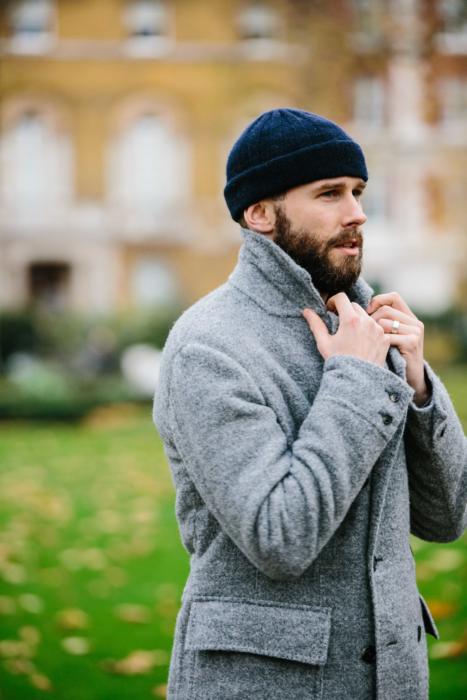
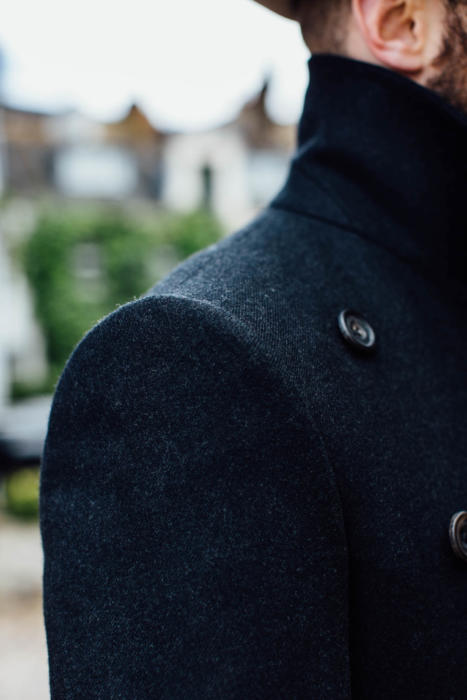
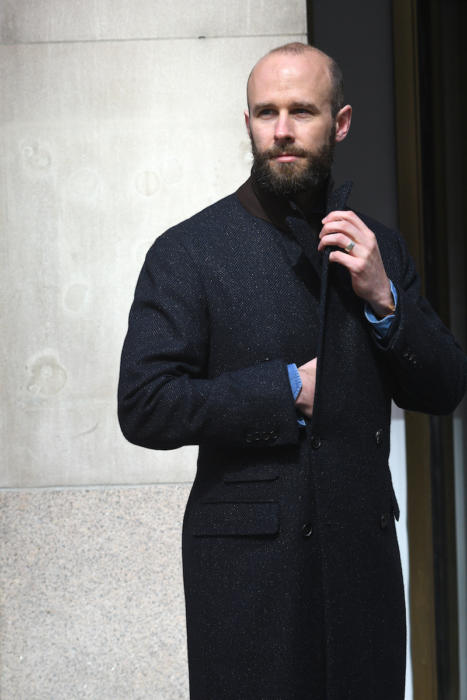
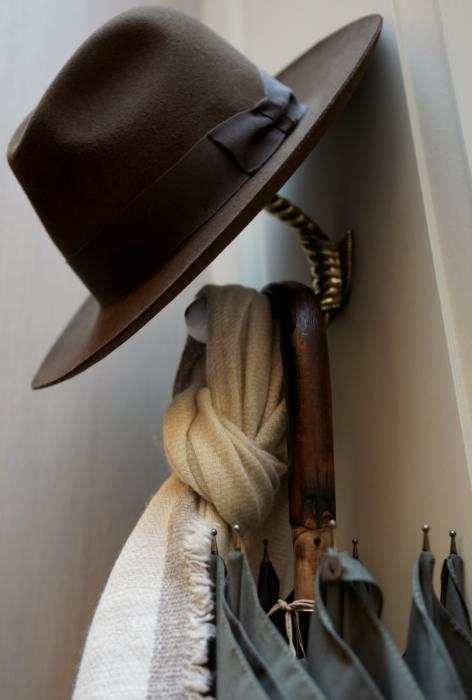
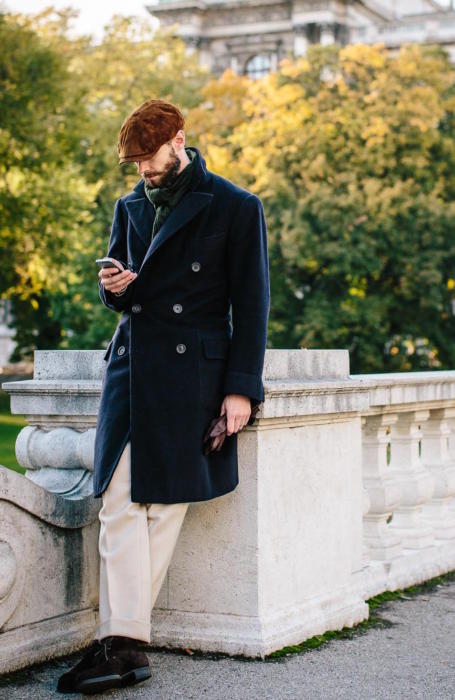
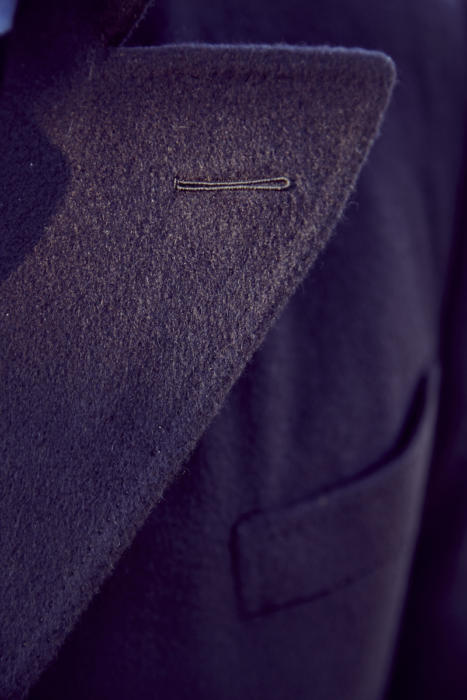
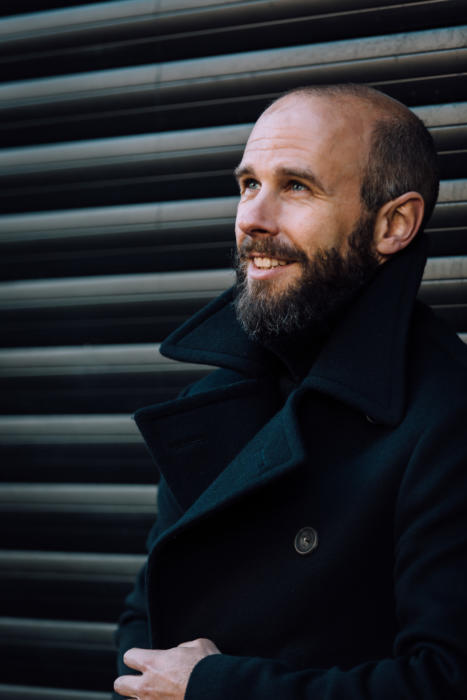
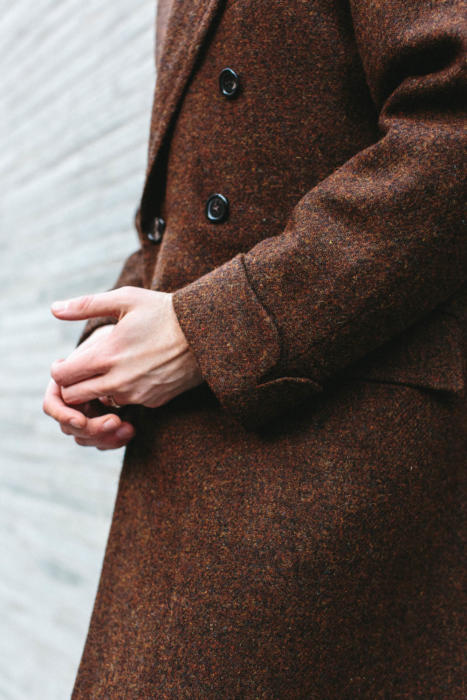
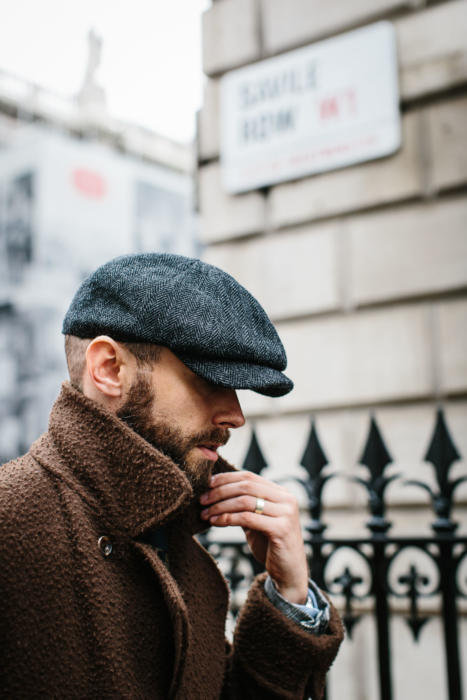
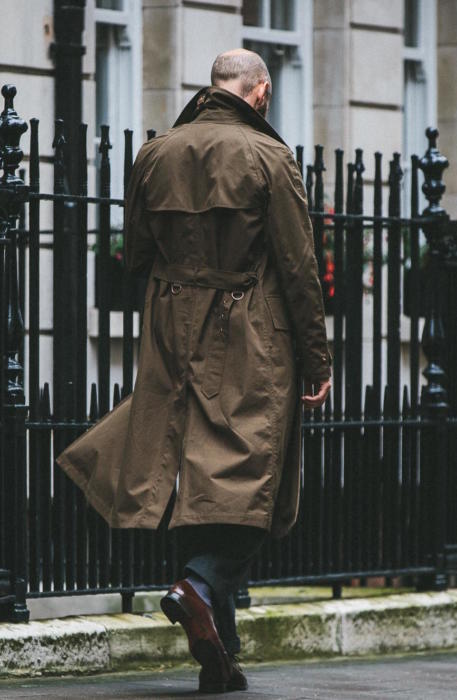
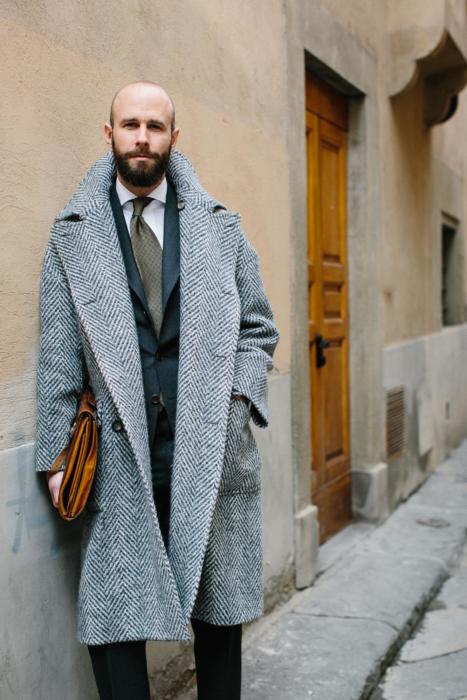
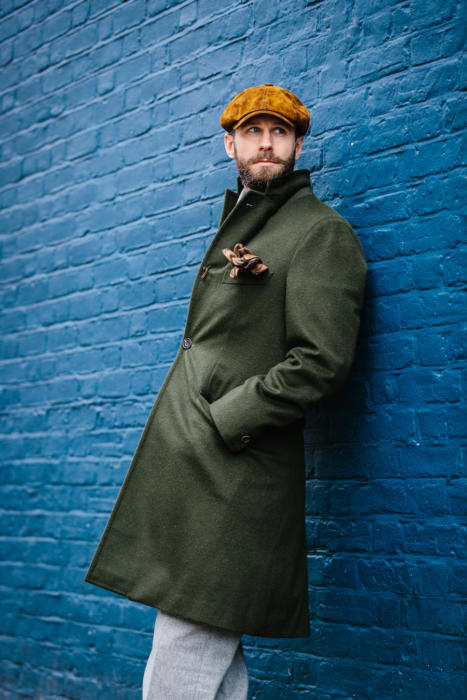
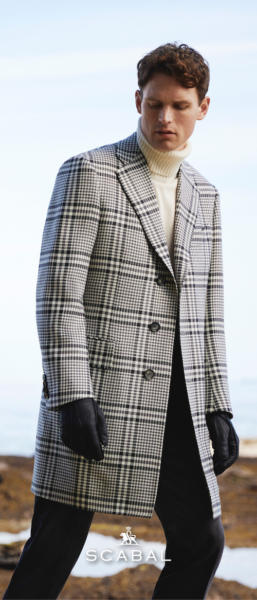
Since you say waterproofing comes at a cost, any comment on the Loro Piana storm system coats? They boast of almost magical water resistant properties, with no loss of quality. Can it be true?
Not quite… There’s a waterproof layer there underneath the wool, which means it’s never going to drape quite as well as a normal coating. It is effective though
How are you converting g to Oz, Simon? I’ve always though Oz meant Oz/ yard^2, and that g meant g/ m^2. This would mean a fabric reported as 500g would ~ as 15Oz, and 370g ~ 11Oz.
Hi Hugh,
Actually most people don’t use yards. However, it does vary between measuring per linear metre (of the cloth) and square metre. Which can be frustrating.
I’ve just taken what the mill quotes as ounces or grams, and converted that directly into the other when I need an equivalent.
So when a mill talks about “Oz” they’re mixing imperial and metric units and meaning “Oz/m^2” or even “Oz/m”? Very confusing! That means when reporting the weight of a cloth there are free different interpretations for the actual mass of it…
Indeed
That is indeed especially confusing, especially if not able to be seen in person apart from small swatches.
PS, I enjoy that there is another Hugh on PS. I’ve never met another in person
Very good guide.
But why didn’t you discuss Loden as cloth although you own a Loden overcoat?
Good point, one more to mention… I’ll add that in
I’d like to hear more about your claim that camelhair wears harder than cashmere. In my experience 100% camelhair coats get worn down around the cuffs, collar, and underarm in a few years.
That should be the characteristic of the fibre Tim. Though of course it depends on other things too, as outlined above
– aren’t all animal fibers hollow?
– I think alpaga is somewhat water resistant,
– are tweed fabrics (always) carded?
– do Escorial fabrics exist for coats? If so, could it be a good alternative to cashmere, being cheaper and possibly less fragile?
-have you ever tried a silk lining? It is said to be fragile and warmer, just wondering to what extent this is true. I am considering a lining made of Cupro and silk, I know it exists although I am struggling to source it.
– I don’t think so, no.
– Yes, good point.
– No, not always, but usually.
– I haven’t seen any, no. Interesting idea though.
– Yes, all my Cifonelli pieces have silk linings. I haven’t found them warmer or more fragile, but then I haven’t worn them very intensely
Thank you. Is it by default or else how much does C charge for a silk lining?
Default
Escorial coating from their Escudo bunch is available by the metre at: http://www.pepperlee.co.uk/coating/bunch-name/escudo.html
I bought a few metres of the plain/ navy. The weight is 470gr, I am having made up in a classic double breasted Crombie style.
Thanks
For those of us likely to buy a coat off the rack some guidance on how to identify fabric weight from the label would be useful.
I don’t think you’ll be able to from the weight I’m afraid Peter. You’ll mostly just have to feel the heft of the thing
A bit astonished, that you were not including animal skins/furs in this list. I have had some great navy shearling coats. It is really perfect for dead cold winters here in NYC and the brushed side of it is soft and neat looking like cashmere. What is your opinion on that, Simon?
I love shearling, I just wouldn’t generally wear it with tailoring
That’s your next project Simon, an overcoat with a shearling lining.
What weight would you recommend for a coat for the depths of a New York winter? 30 oz? 35?
It’s hard to know given I’ve never lived through one… Anyone else have a view?
Above a certain weight though, you’re really going to be layering instead/as well
I live in Montreal and have found that most overcoats are great until about -10 to -15 degrees celsius, depending on the wind chill and humidity level. Below that and although more casual, a down parka is difficult to beat in terms of warmth. The challenge lies in finding one that you can wear with tailoring.
I live in the Niagara region of Canada which is just across the river from upstate New York, so hopefully a rough approximation of the weather in which you live. I have a 32 oz peacoat. Wearing a heavy sweater underneath, I find it is ok down to maybe -10 degrees Celsius (I’m assuming here I’m spending 30 minutes or more outside). Below that, I get uncomfortably cold. A complicating factor here is that it is a peacoat, so it isn’t very long.
I have a heavy wool chesterfield my Dad bought in England in the 1980s (St. Michael’s is the brand, I think). I don’t know the weight, but I’d venture it is probably in the 28 to 32 oz weight given how it feels compared to the peacoat. That I’m ok to wear to -20 or -25 degrees Celsius with wind chill added on top of this, assuming I’ve layered a light weight merino sweater with a tweed jacket.
Below that, or if I’m more lightly layered, I will usually go to a down parka–style becoming subservient to comfort. If I really needed to look stylish outdoors, I’d probably be fine with the chesterfield and deal with feeling a little cold, but I’d be wearing my down gloves or mitts, ear coverings, and a relatively heavy wool hat (not cap/toque) to manage the worst elements of the cold.
When I get around to doing a bespoke coat for the real cold, I’m sure I’ll get a cashmere/vicuna/alpaca fabric, get it double breasted (two layers of insulation at the front!), and ensure the ability to button close the front as well as the skirt and vent. I’d also look at inner elastic cuffs for the ends of the sleeves to keep the wind out. A good fit at the waist is also critical for warmth–you’ll feel the cold air blow up the coat and the warm air get pushed out of it as you move if you don’t have a good fit there.
Hope that helps.
Very useful. Thank you
Hi Chancellor,
St Michaels used to be an in-house brand for the department store Marks & Spencer in England.
I’ve been in NY for nearly 30 winters of my adult life and they are surprisingly mild, ever more so lately… In grams, anything 500g and above should be fine. You can get greater warmth with layering, and covering the hands, neck and head.
I just picked up a 460g cashmere double breasted coat. Albeit I “run hot”, I have been perfectly comfortable on the coldest NYC days so far with a winter weight suit underneath.
I agree. Layering and accessories are the key. I’m fine in a 3 piece suit in a 13-14 oz. cloth, hat with ear coverings, scarf, warm gloves, and an overcoat in a standard 20-25 oz. weight for temperatures down to -15 C. So long as you’re moving and not standing still, I don’t think it’s necessary to search out heavier cloths. The accessories make the biggest difference in being fully covered. An astrakhan is also worlds better and more appropriate for these temps than any type of fedora/trilby.
A nice overview, Simon. One edit – it should read: “…looking at 600-700g, or 20-23oz”
Excellent article excepting, in the real world , rain wear aside, most of us only want/need one overcoat.
With that in mind, what would your definitive recommendation be and why ?
Navy heavy wool. Maybe with a nice herringbone pattern in it.
Navy will be the most versatile, unless you never dress smartly.
Simon, looking for informational about the appropriate height/length/placement of the split on the lower rear of the coat. I’ve seen some starting 8 inches from the bottom (on a knee length garment), and I’ve seen some running from above the waistline.
I will always go for good quality cashmere
I’ve had an overcoat made in a 20oz navy wool with a thinsulate zip out inner shell through the body and sleeves.
Without the shell is good for coolish weather. With the shell is perfect for freezing winters in NYC.
By the way Simon you have overlooked a point of significant importance; weight is one thing, but DENSITY is the way to protect against wind.
Yes, good point. That would be getting into a whole area of set of the loom, weave structure etc I guess. But it’s also something people can try to bear in mind when they feel the cloth
And then the inevitable question who is a good tailor for an overcoat? Any particular recommendable? Should I go to Savile Row or to Italy or perhaps somewhere else? And the price I should expect for a good overcoat? Around GBP 6.000,- for bespoke? And for RTW perhaps around GBP 3.000?
It’s almost entirely about style – which style of coat have you seen that you like?
Prices range a lot, a Graham Browne or Whitcomb & Shaftesbury up to a Huntsman or Cifonelli. But most will be less than that
Perhaps it would be interesting for people if you could go deep in explaining different styles of coats in depth in a separate post? And then hopefully a bit about coat tailors as well?
Sure, will do Rune
Great article, timed just right for (Northern Hemisphere) winter. A pleasure also to see many of the PS coats in one article. Roughly, I think eight coats cover the bases, from light to heavy: rain mac, covert, camel or fawn wool, chesterfield, ‘king’ coat (double breasted town coat), tweed country coat, crombie, British warm or guards type, duffel. Of these I find the the mac, covert and crombie get the most wear. Understandably, if I were in the cold of NY something heavier would be useful. N.B. paras 15 and 24 read rather strangely i.e. ‘that work the deserves’?
Really helpful post for whenever I get around to commissioning a bespoke coat.
A couple of follow-ups (one of which isn’t really about the cloth, but I don’t think there’s another general overcoat post you have done):
1. You discuss cashmere and vicuna as warmer cloth. Camel you mention as soft and luxurious but don’t comment on its warmth. Would it be similar to wool or maybe a little less warm (I assume camels don’t want to overheat and just need some insulation over cold nights)? And on a similar vein, any comment on alpaca as an overcoating?
2. Do you have any thoughts on regional tailoring styles (Saville Row v. French v. Northern Italian v. Neapolitan)? Would it just be a matter of style (amount of structure and extent of finishing details), or would there be other differences of note?
Thanks!
1. Camel should be as warm if not warmer than wool. It gets very cold in the desert at night. And no, no experience with alpaca I’m afraid.
2. On styles, I’d go with English if you want something formal pretty much just with a suit. Non-English if you want it to be more versatile. But style elsewhere is hugely important, particularly with a DB. Find a style you like and have seen, and go with that
Wow, what a beautiful collection of coats. Unfortunately I’m still at the beginning. I’ve heard of something like a rule that you should avoid notched lapels on DB coats. What do you think of this rule? I found a nice DB coat, but it holds me back.
Simon, excellent article on a topic that has been on my mind. What manufacturers do you like for the wool/cashmere (20% approx) mix fabrics in the 20-25oz weight range ?I attended two of your events this year. Hopefully get to see you again in 2019. Merry Christmas and Happy New Year.
What about a wool/silk mix? How will that cope with rain etc
It would be a little more rain-resistant, but still a long way from what you’d want for real rain protection. Care and prevention are still going to be the best
Hi Simon…Am I correct in saying that the Private White PS Bridge Coat is around 22oz and their Pea Coat slightly heavier, at 30oz? I think you mentioned previously that warmth wise they would be comparative, due to the 20% Cashmere in the Bridge Coat?
Yes, that’s right. The heavier melton would probably be slightly warmer, but not a lot
Simon,
Thank you very much for this article.
I wonder what was used for coats that were designed to stay outside for hours during “real” winters.
I am thinking here about cold, continental winters (<-15C) and military (or similar) use.
Were these coats somehow insulated (down / fur)?
Sometimes fur collars, but no mostly just heavy dense wools, and layering (wool shirts, wool underwear, wool jackets….)
Apologies for the confusion Simon. My question is what mills do you like for the 600-700g 20-25oz wool / cashmere mix (approx 20%)..e.g Scabal, Holland & Sherry, Loro Piana, Hardy Minnis etc..Thanks
I haven’t really done an overview of all the bunches – I would say pick on feel, weight and colour though. Don’t pay too much attention to the brand name
Top coat , overcoat …?
Always tricky given they are mutually exclusive and the milder weather in temperate climates means they have limited use.
I suppose what most people want is a happy medium between the two. maybe a bridge coat?
Off Topic but did you see Harry Kane at SPOTY? I thought he looked great in very smart double breasted grey flannel suit, perhaps from A&S?
More likely to be from M&S as they provide suits for the England team.
Thank you for a very informative article Simon. I’m usually not layering much because otherwise I’m way too warm at the office so tend to have warm coats. I’ve got a 700gr huge glen check from Holland and Sherry, made as a polo coat by WW CHAN. It proved a great investment vs the cold Luxembourgish winter. However we rarely go below -15 Celsius.
Simon, another great post. A related question – what colour overcoat would you wear over a tweed blazer? I have a tweed blazer very similar in look to your donegal suit made by Dalcuore, which I wear with navy chinos. I can’t quite fiend the right overcoat to wear over it though. Navy seems too formal and grey seems to jar with the tweed. Any help appreciated. Thanks.
Hmm. Perhaps a dark green, eg loden? I would have thought a big grey herringbone would have worked as well?
Speaking of coats, just received my Bridge Coat and it looks fantastic. Perfect length and lovely soft material. And that collar!
Amazing! So pleased
Excellent article. Thank you. Did you post a separate article discussing the unconstructed grey coat at the top of the post? That style always catches my eye.
Thanks Simon for a very informative an interesting artickle.
I have bought several vintage Alpaca coats in excellent condition and was curious of what you think if Alpaca for cloth in a coat.
Best regards
Tom
I don’t own any so can’t really speak to how they wear, but I’d go for plain wool if I had the choice, or cashmere if I could afford it
Hi Simon,
I have looked forward to an article about various overcoat cloths for a while. There are some questions I have regarding overcoats. Firstly, fabrics such as guanaco and angora which I have a read about being fibres used to make overcoats; I have never found any comprehensive sources or images of what the texture of overcoats in these fabrics look like, and what their benefits are.
Secondly, apart from typical overcoat colours such as – Navy, grey, black, various shades of brown and green, camel, and the caramel colour of vicuna. What would be another classic or neutral overcoat colour worth considering?
Lastly, what are your thoughts on overcoats in bold patterns like Plaids, tartans, and checks? Are such overcoats too fashionable and what would be the ideal fabric for such an overcoat. I have always entertained the idea of a patterned overcoat, for informal wear with casual garments, namely odd jackets and sweaters.
That’s all of my questions. Thank you for taking the time to read my comment.
Kind Regards,
Sasha Perera
Sure Sasha.
I can’t help you with guanaco or angora I’m afraid. Personally I would look to different finishes on wool rather than these different fibres.
That’s quite a lot of overcoat colours! I’d mostly look to shades within those, or weaves that create different textures – Loro Piana often has great greys and creams like that. And then there are tweeds of course.
On patterns, personally I wouldn’t except for something like a herringbone. Even with a wardrobe like mine, I’d prefer to vary colours, weights, cuts and textures.
Winter coats can be great fun to play with. I am able to visit many of the great mills in Yorkshire & Lancashire and often you can browse bunches in their mill shops and buy at VERY low cost then have it made up at a local tailor. For example, I saw an old photo taken on the Queen Mary in the ‘40s of a fantastic coat worn by non other than Stan Laurel Just the thing for cold Atlantic crossings!
After some research I established it to be a Polo “wrap” coat, no buttons, Ulster Collar, Raglan Sleeve, Martingale belt and turnback cuffs. I bought a length of Camel hair from Dormeuil’s mill in Huddersfield and had it copied with a cupro lining by the very same tailor who made the Beatles stage suits when they first went to America. The Mrs stole it though.
However, I have never found a tailor able to make a classic trench coat.
Re. insulation, there are technical solutions such as ultra thin insulative membrane linings and also hydrophobic nano treatment such as P2i that are undetectable on fabrics.
Something I don’t understand:
“A top coat would also usually be shorter, finishing just above the knee where an overcoat would be below it – which will also reduce its warmth.”
Why would the shorter topcoat be warmer than the longer overcoat? It sounds counter-intuitive.
Perhaps badly put. I meant the top coat’s length will also reduce its warmth
It’s worth pointing out that when you choose your cloth for an overcoat the higher up the weight scale you travel the more difficult it is for the coatmaker to execute certain parts of the garment and therefore what you gain in warmth and drape you may loose in detail. Think double breasted points in a 32oz British Warm – not a good idea.
Very informative, particularly the importance of investing in a navy cashmere overcoat above all else.
I’ve read Escorial makes a fine surrogate to cashmere in jacketings. Are they available as suitable overcoating cloths?
Thanks for your time.
Yes – see comment above from a reader
Thanks for the reply and the heads up. I’ll keep its availability in mind when seriously consider ordering a bespoke coat, weighing the pros and cons of different fabrics – cashmere, Escorial, cashmere-wool mix, camel, etc.
Is that your new Chicago hat on the hook in the photograph, Simon? You really have an astonishing wardrobe and are looking ever cooler! Also incredible what you must know to answer the readers’ questions!
No, that’s an A&S one… it’s an old shot from the Haberdashery
Thanks for this article. Several questions:
(1) What do you think of navy herringbone as a more casual alternative to normal navy? I have a friend who has a navy herringbone tweed that goes well jeans and sports coats. I imagine it could work over a suit although the look might be more casual.
(2) I already have a plain navy topcoat (and your navy bridge coat). Would herringbone be good for a second coat? Between navy and mid grey, which would be more versatile? (I have dark blond hair and blue eyes, so I tend to wear navy a lot. I have several mid grey and charcoal suits but no grey coat. Perhaps time to diversify?
Herringbone is a really good option. If you already have a plain blue and the bridge coat, though, I’d branch out into grey. Perhaps with that herringbone
As you mentioned that cashmere is maybe a bit fragile for a day in, day out overcoat, but that camel hair is harder wearing, would you say it is then adapted for that use? As well, what do you think of a navy camel hair overcoat?
Thanks
Navy camel hair could be a good choice. It’s a little harder wearing, but it’s main attraction is it feels close to cashmere but is a lot cheaper
Simon, just to clarify, would camel be hard wearing enough to be a day in day out workhorse overcoat? And would 20-25oz be heavy enough, given camel’s additional insulating characteristics?
Yes I think so, on both counts
Hi Simon! I am looking to buy my first bespoke coat and, following your recommendations, am searching for a midnight/navy wool or wool-cashmere cloth between 20 and 25oz. Is there any cloth you would recommend to me in particular? Thanks a lot in advance!
Not particularly Sebastian – try the overcoating bunches from the likes of Fox, Holland & Sherry, Loro Piana, Harrison’s
Dear Simon,
What lining would you consider for added warmth to a heavy overcoat, let’s say 27oz wool. In one video D. Cabrera mentioned that Huntsman do cotton twill lining for added warmth. Do you think it would be warmer than Cupro? Would Cashmere work as a lining or would it be too delicate?
Kind regards,
Alex N.
Personally I wouldn’t change the lining, Alex. Cotton would be warmer, but also annoying getting on and off. And cashmere wouldn’t wear very well. If you want extra warmth, get a heavier cloth or a warmer one (eg cashmere not wool)
Dear Simon,
Following your advice I sought for a long time and managed to get a hold of a 36oz pure cashmere Navy overcoating fabric. It’s simply out of this world and am looking forward to having it made next year perhaps. I would be looking at either Steed or Liverano to do a double breasted Ulster. Those Liverano’s are amazing.
I don’t mean to be boasting but I am so proud of finding such a cloth. They are rare but exist. I simply wasn’t convinced that 22-26oz cashmere is the heaviest there is. I did have to sacrifice my next bespoke commission for it but hey right now we don’t really need suits.
Best,
Alex
Wow, that does sound amazing Alex. Let me know how it turns out – and if you can, how you found the cloth
The cloth was woven by Lovat mill on request of the London Lounge cloth club and was done years ago. Recently, they had been reorganizing the storage and found a forgotten length and it was mentioned on the forum and I happened to be online when that happened. I knew of its existence and was hoping for more than a year to find it somehow, so I am very glad I did. And was a perfect length 3.5m, not some odd length.
Best
Alex
Aha, great, thanks Alex
Alex, if you see this comment, would you mind saying where you ultimately went for the overcoat? Thank you!
Hi Simon,
I am interested in getting a casentino overcoat but as I understand it from speaking to people in the industry, there is only 1 mill in florence that does a proper casentino- the name escapes me, do you know the mill and is this true?
I don’t know I’m afraid – I’ve never had something made in casentino and looked into it
Dear Simon,
I just read the article you wrote on The Rake’s casentino Ulster coat, where you said that you were warming up to casentino. How have your feelings evolved? Do you like it now? If not, would you mind sharing your reasons? Thanks.
I like it more than I used to, but it’s still not a favourite fabric. It has none of the softness or other tactile appeals of normal wools or cashmere. It’s real appeal is mostly that it’s unusual, and perhaps quite casual in its fluffiness
Hi Simon,
I managed to get my hands on a very interesting Kiton overcoat (Navy DB 6×2, fully canvassed, turned-back cuffs, patch pockets, below knee length, pleats above and below the half belt) with an unusual 77% Cashmere 23% Silk blend.
Though, I did not succeed in finding the mill nor the weight of the cloth, I assume this blend was not used for cutting costs as the original price tag was over 7100 euros.
What are the advantages (or drawbacks) of such a blend versus 100% Cashmere?
I’d imagine it would feel a little lighter and perhaps have a little sheen, and might be less robust or warm. But it depends on other things a lot too, like the weave
Just reading your post now, I am having my first bespoke coat appointment this sunday. I wanted to go for a dark navy double breasted, over the knee / calf length. I don’t see them in a lot of posts tho.. What would you say? Should I go for a green of camel coat rather? Wanted to make this one my work horse for years to come.
No, not at all, navy would be a great choice. My navy DB is my favourite coat ever.
See pictures here:
https://www.permanentstyle.com/2016/11/the-cap.html
Hello, Simon.
I plan to purchase the Stoffa 007 Raglan coat later this year and am trying to decide between fabric options. This coat will be mainly for work, but also for the weekends. I rarely wear a jacket and my office dress code is business casual, though I’d like to be able to wear this over a suit if needed. This coat will be my first proper wool coat.
Stoffa offers the coat in a double-faced merino wool in navy, charcoal grey, and grey herringbone (550 gms) and a natural wool in cream, taupe, light brown, and chocolate double-faced flannel (580 gms). If you’d like, you can reference the colors here:
[Double-faced merino wool] https://stoffa.co/blogs/la-stoffa/in-studio-winter-textures
[Natural wool] https://stoffa.co/blogs/la-stoffa/introducing-natural-wool
Might you be able to offer any suggestions for the most versatile fabric option? I live in the US Northeast and while weight is a consider, I’m unsure if the 30gsm difference would make a difference when worn.
Thanks for your time, Simon.
I’d suggest the grey herringbone or dark brown, Jake. Both would be smart over a suit, but also work with more casual clothing. Navy might be too smart, some of the others too casual
Hi my name is Malik, I have a company called Lonitaly Fashion.
When is the custom Tailor and bespoke tailors going to wake up to the fact that if you’re dressing properly and you have on a gray suit don’t you think you should have on Gray shoes.
What if you’re wearing a blue suit don’t you think you should have on blue shoes to match
Those both sound like pretty terrible combinations, to be honest Malik. Flash and ill matched
There is a body of well reasoned thought on style that argues that it is black shoes only that you should wear walking around on concrete in a city or large town and that brown shoes are really only suitable for walking around on grass or fields. Naturally this has not been common thought for at least 40 or 50 years but I do wonder whether it will return.
Personally, I think that made most sense when the rest of the clothing was also that formal, and when society as a whole was. I don’t think shoes can be seen in isolation in that sense.
It is certainly a factor to consider, though, that those dark and cold colours often suit urban environments more.
Hi Simon,
Not sure how to reply on my previous comment, but thank you. They advised my a Caccioppolo 520gr double face wool, it felt great to the touch and looked good. But as I am rather a new to all this I wonder if this would cope with Dutch winters, what would you say? I don’t want to have to turn to another coat when it is lets say 2 degrees celcius or something. Also I am wondering what the double face wool adds? I read that there is no lining needed with double face, but doesn’t that have a negative influence on the lifespan? Do you have any tips or tricks I should as for?
I find the way the shoulder is on your Michael Browne coat absolutely amazing by the way.
Thanks David.
If you want it to be able to cope with those temperatures, I would go for something heavier.
With double-faced fabric, it’s less that you don’t need lining, and more that it’s nice not to have it, because you can see the other side of the cloth. But personally I wouldn’t prioritise that. You’ll barely see the other side anyway.
What weight would you recommend for a wool overcoat for London if someone is freezing easily?
I’d suggest the 20-25oz range mentioned in the article. That should be sufficient. Layer up for extra warmth
Hi Simon, what wool coat fabric would you recommend? And what are your thoughts on Cerruti cashmere for coats? Thanks!
Hi,
In terms of weight, pattern and so on, a lot of the recommendations are above.
In terms of picking between mills and merchants, the advice generally holds that these aren’t that different from each other. And indeed some make cloths others carry. Italian mills tend to make slightly lighter, looser weave overcoatings, but it is a big generalisation.
I’d suggest reading the Introduction and the first chapter from this guide, perhaps, for guidance on the latter.
Thanks
Is it better to buy a seperate overcoat for knitwear or is an adjustable overcoat like your Vergallo/Ettore de Cesare a good solution? I’m asking because you said an adjustable coat for both tailoring and knitwear is always a compromise.
An adjustable one like that makes a small difference, but only a small one. Because most of the issue is in the shoulders and chest, not the waist.
Whether you should get a separate coat for knitwear depends on your budget and how many coats you have. Also how much you care about the shoulder being a little bigger when not wearing a suit jacket. Personally, I find it’s fine with a cut that’s a slight compromise between the two. I’d generally prefer that than coats that only work with knitwear
Can a tailor make an overcoat with a fur lining (like the ones of Loro Piana)?
Not usually on their own, no, but they can work with a furrier to do so. Eg some use Yves Salomon, London and Paris
When the first overcoat is a navy DB and very heavy, would you make a second lighter topcoat also DB or SB?
Would you choose a different colour or stick to navy since the two coats are worn in different temperatures (suits are mostly navy, some charcoal grey)?
I’d stick with DB myself, as I like them so much.
And navy would be safer on colour, but I’d find it hard to do two so similar.
I also like DB coats a lot and don’t want to have two similar coats. What colour instead of navy would you choose? Charcoal grey? Dark Brown? Camel?
I like dark brown because I think it looks great with navy and also looks good with charcoal grey suits. Charcoal grey is also a nice colour especially with subtil herringbone but I’m unsure how it would look with navy suits.
I’d go for mid to dark grey, or dark brown.
With the grey, go for something with a big herringbone pattern, to help it not look too similar to grey suit.
I always had problems with temperatures where my heavy DB overcoat is too warm but my trench coat is too thin. The temperature range is approximately between 0 and +10 degree celsius. What weight range would you recommend? Up to what temperature do you wear a trench coat and when do you change to your topcoats?
It sounds like a topcoat, perhaps still DB if you like it though, would be a good idea.
My Ettore de Cesare is only 16oz, but you could go up to 18 at least and it would be good.
I tend to wear that rather than a trench coat to be honest. The trench is for the rain mostly.
Of course, there are layers in between all that. Scarves, knitwear etc
How important is the structure of overcoats (padding and chest canvas)? I could imagine it’s less important than at suits and also less variation in amount/weight?
Is there a big difference between the structure of an English overcoat and a French (like your Cifonelli) or Northern Italian (like your Liverano) one? If yes, which do you prefer and why?
There is, roughly, the same variation in structure. It perhaps makes less difference, given the cloth itself will be heavier, but the differences are still all there.
I would also say that there are substantial differences in the style, even though it wouldn’t initially look like it. For example, English coats tend to be cut with a fairly small collar – essentially the same as a jacket collar – and are really intended to just be worn down. More like a long jacket. Whereas Neapolitans generally prefer an Ulster style with a deep collar.
I prefer coats with a little less structure, as I’m more likely to be able to wear them with different types of clothing – eg just knitwear. And so more French or Italian, less English.
Hi Simon,
Hopefully I’m not too late to ask this question but could you please let me know if the weights referred to in your article are per linear metre or per square metre of fabric? At first I assume that that everything was per square metre but from looking at the available fabrics in the market I now suspect that almost everyone quotes weights on a per linear metre basis (assuming a 1.5 metre width).
Kind regards,
Stuart.
I’m afraid I don’t know on all of them Stuart – the only thing I can is that we’re quoting the weights that the mills do. I haven’t checked with all of them which they’re using
I’m currently planning to order a classic ulster coat to my tailor, but I’m a bit puzzled on the choice of the fabric. I’m considering cashmere (oz. 15 1/2) or camel hair (oz. 17 1/2) in the classic “camel” color. I’ve never owned a coat made of these materials, and due to their cost I would like to make the most appropriate choice. Considering the pleats in the back of an ulster coat, which might lead to additional friction of the fabric when seated, and the more “casual” nature of this type of coat, maybe camel hair would be appropriate since it’s more resistant then cashmere. In the other hand I’m sure of the impeccable result of cashmere, but more in doubt of the overall look of camel since it is much more hairy and I’m not looking for a too “rough” look. Did you experience both fabrics ? what would you suggest ? Thanks
I don’t think you’ll think the camel ‘rough’ at all. I think it will feel really nice still.
I’d worry about those weights though – those are very light. I’d be looking at 20oz plus really
Hi Simon!
I don’t suppose you’ve ever worked with heavy moleskin for outerwear (in particular for overcoats)? Obviously it won’t be as warm as wool, and definitely cashmere, but I was looking at the heavier options from Brisbane Moss, perhaps for something that develops a nice patina over time, as cottons do. I was wondering what your thoughts were?
I haven’t ever used it William, so I can’t with much experience. But I’ve never particularly liked moleskin for jackets or coats – it doesn’t seem to have any drape really, shows wear and marks easily, and isn’t that warm. I think you’re generally better off looking at any wool for a coat
Mr. Crompton, I am considering the possibility of purchasing a RTW camel overcoat as my first one. I indeed like It very much, but wearing a camel overcoat in my country can be a bit flashy. Is there any advise you can give me on that point? Thanks in advance.
Hi Juan,
If in doubt, I would avoid a camel overcoat if you think it could be seen as flashy. You need a good overcoat to be able to be worn with anything, and not always draw attention.
I speak from experience! As mentioned in this post.
S
Hello Simon,
I am thinking about commissioning a overcoat in the near future and I was wondering what do you think of calvary twill as cloth. I am considering going with Standeven Snowdownia bunch calvary twills. If not could you give any other suggestions to cloth when it comes to covert cloth? The only one I know is VBC’s Covert which is probably not heavy enough for a place like Hokkaido,Japan.
I’ve never had a covert or cavalry twill for an overcoat. I think it would be very nice, but also pretty smart – it will be sharp, and look best with smarter clothing I think. If that’s what you’re after, that’s fine.
I’m afraid as I haven’t looked at it for overcoatings, I don’t know any. But the first places I’d look would be Holland & Sherry, W Bill and Fox coatings
Hi Simon,
Moving this from email over here per your request:
I’d love some suggestions for *very* warm/heavyweight cloth bunches for a Liverano Ulster (I live in Minneapolis, so I’m not messing around when I say I need the coat to be WARM).
I can say more about why if it’d be helpful for you, but what I’m looking for almost for sure falls into one of two general categories:
I’d be inclined to ask you anyhow – but by coincidence, it’s possible the answer begins and ends with the cloth from the Polo coat you did with The Anthology:
https://theanthology.net/chronicles/the-anthology-x-permanent-style-polo-coat-in-herringbone-donegal-tweed
That cloth basically fits the bill in every way; fingers crossed it’s available by the length from the mill (I’m planning to inquire Monday)! And maybe it’s part of a bunch with other interesting options as well?
Still, any other suggestions would be welcome as well. Thank you in advance!
Thank you Ben. It’s much easier to answer people here – because I can link to relevant articles for example – and easier to spend time on the replies, as I know thousands of people will see them, rather than just one.
The Anthology cloth is from Molloy & Sons, and while they do some cloths by the cut length, it’s a very small part of their business and I don’t think this cloth is part of it. You can check with them if you wish. (Or ask Liverano to check – most mills also don’t deal directly with customers, as I’m sure you’re aware.)
In terms of warmth, you’ll be able to find overcoatings from most mills that go up to around 27-29oz, which is the same here. If you look at the Holland & Sherry website, for example, search overcoats, and filter by weight, you’ll see those options. My Ciardi ‘British Warm’ is from that selection, and is probably the warmest I have.
However, if you were to have some cashmere in there, or it were all cashmere, it would be noticeably warmer. Look at W Bill, Loro Piana, Lumb’s Golden Bale and see what options there are there. Most do a few herringbones, or twills with some decent textural interest.
S
Thanks very much, Simon – very helpful.
Quick follow-up Re cashmere (and I suppose camelhair and the like):
What weight of cashmere would you be looking for for this sort of very warm coat?
(I know cashmere has a much higher warmth-to-weight ratio, so I don’t have the same frame of reference there.)
I’d still look for the heaviest you can find, up towards 30oz, given it sounds like the coat can’t really be too warm for you
Got it – thank you again!
Hi Ben. I’m aware of Harrisons 84836 which is a 30 oz cashmere. I think it’s in British Warm taupe, or maybe slightly darker. https://www.harrisons1863.com/product/84836/
Do share back what you learn. I live in Canada and would like to commission a very warm overcoat the coming years as well.
Will do!
Currently leaning toward a 23-oz navy camelhair from Standeven’s “Snowdonia” bunch – but as I just said in my new post above, I’m still holding out hope for a truly heavy cashmere, if a bunch exists anywhere.
As for the cloth in the link you provided, it’s actually NOT cashmere (the name of the bunch is misleading, as not all the cloths in it are actually cashmere…).
A follow-up here:
As I think you’ve mentioned elsewhere, finding cashmere in >20 oz is tough these days!
Any ideas on that front?
Even the 22-oz Harrison’s cashmere you used for your Cifonelli overcoat doesn’t exist anymore (at least on their website).
Any ideas would be much appreciated!
I don’t I’m afraid Ben, I haven’t looked in a while, but I think Holland & Sherry still does some? I’d certainly look to the English mills – H&S, Harrison’s, W Bill, Dugdales, Fox etc
Thanks again, Simon – no luck with any of those, but I’m also checking with Joshua Ellis and Johnstons and it looks like some interesting things might turn up there.
Also, Standeven is now making a 28-oz doubleface navy escorial that I’m getting a swatch of.
OK, thanks
Simon, I’m trying to decide between two fabrics for a knee-length overcoat in HK, worn over sport coats and suits:
HK winters are really between 12-19 C, albeit I get cold easily.
Currently have a 600g 70% wool 30% polyester balmacaan that I think is the perfect weight for me.
Have a ~350g 100% wool flannel overcoat that is a bit too light/not warm enough for me.
Concern is that the 75% cashmere and 25% wool 500g mix might be too warm. But I also feel like I’ll regret not buying the cashmere (difference in price between the two cloths is inconsequential).
Aware that this is a very personal thing but appreciate any thoughts you have. Thanks.
I don’t think you’ll notice a big difference between those two, Greg, given neither is completely cashmere or completely wool, and the weight is not that heavy. I’d go with the cashmere if you feel you’d appreciate that
Thanks, Simon.
Taking this on a slight tangent: how much warmer is cashmere over wool? The practical question I’m wondering is if getting a heavier weight in wool versus a lighter weight in cashmere, where is the trade-off? Let’s say we’re looking at cloth in the 30 oz range.
I’m not sure how to quantify it. I’d say I notice the difference, certainly, but I’m not sure if it’s a 10% difference or a 30% one. I suspect probably somewhere between those two. Depends also on the wool – the type, the density of weave
Hey Simon, thanks for the useful guide! I was wondering how many fabrics do you need for a overcoat if you buy fabrics yourself?
No problem.
I’m not sure what you mean by how many fabrics though? You mean how many metres of fabric? Or how many different colours of coat in a collection?
I mean how many meters of fabric.
Aha, I see. Sorry if this sounds like I’m avoiding the question, but you really need to ask your tailor. There are a lot of variables here, more than with a suit jacket. Length and double breasted or not, for example, make a big difference. Then there’s the vent in the back, if there is one and how it’s made etc
Simon,
I am looking to get cloth for a second coat. I follow your suggestion of Grey herringbone, an am looking for one in the right weight. I want something lighter as I live in a warm country. Dougdale Bros. are my best option for logistical reasons (I need to order the cloth and almost no merchant sell by meter, as far as I can tell). Their Coating bunch option is too warm (25oz). I found their Fearnought bunch which is lighter, but described as a suiting bunch. What would be he difference from a coating bunch? Is it good enough reason to avoid this cloth?
Thank you in advance.
I’m afraid it is a good reason to avoid it, yes. The suiting bunch will be woven tighter, probably from a finer or worsted yarn, and look rather sharper and sleeker.
You’re better off looking at Italian mills if you want a lighter coating. Though I realise those might not be accessible to you
Right, perfect. Thank you very much.
Thanks for the article, Simon! I learnt a lot from you!
Just one question about cleaning. I’ve always hand washed my 100% cashmere pullover in cold water, and they all turned out fine, well maybe except one 100% cashmere scarf which doesn’t look quite straight near the end.
I just bought a 100% cashmere coat from an Italian brand (above knee and around 30oz to my surprise considering how light it is when I try it on), can i hand wash it in cold water as well? The coat label says dry cleaning with tétrachloroéthylène and no dry cleaning with water. If not, what other solutions apart from do you propose? I’m quite nervous that dry cleaning might damage it.
Thank you!
Dry cleaning shouldn’t damage it, unless you do it a lot or it’s a structured coat.
But you can do a lot by brushing, airing, the occasional sponge or cloth. Have a look at our care section in the Categories in the menu
hey Simon, would you recommend a overcoat made from Alpaca wool? I heard that alpaca wool is really really good at isolate the cold air, is that true? could you tell me how much alpaca gonna cost usually(like per meter)?
I’ve never really looked into it Jan, sorry. My instinct would be to stick with wool unless you already have a couple of good wool coats though
alright, thanks!
Hello simon im wondering to make ulster coat and raglan coat,and im having problem with choosing fabric i want cashmere 100,but fabrics are
So expensive these days, to be honest i think i will regret now using cashmere,in this case can you give me advise or recommend fabric?
I would go with a wool/cashmere mix, definitely. It will wear better in the long term too, and 20% of cashmere or so will give it a really nice touch.
My first stop would be H&S overcoatings, or W Bill and Fox. I’m having a great wool Fox made at the moment, with Ettore de Cesare
Hard to find blended ones haha
Not about coating but can you recommend me for great solid navy grey fabrics for suit? I am rebuilding the wardrobe
For suits, have you looked at the suits chapter of this guide? Most of my advice is in there
Excuse me simon do you know companies who sells fabrics to individuals?
Fox Brothers do, Holland & Sherry have started doing so but it’s more through phoning them up than an online store. I think there are one or two others but I can’t remember them off the top of my head. Most are only set up to sell to tailors though
Hi Simon, May I please ask couple of questions regarding coats cloth? I am due to commission my first ever mtm coat and thinking of double breast knee length raglan coat. My questions are:
1. Is something like Fox military issue 34/35 oz too heavy. I live in Amsterdam – so weather is quiet similar to London.
https://www.themerchantfox.co.uk/collections/coating/products/fox-military-issue-navy
2. Should it be full canvas / half or no canvas.
3. Finally, should it be lined or unlined?
Thanks in advance.
AKG
1. I think that might be too heavy, yes. A lovely fabric, but you might find it’s not something you can wear a lot of the time.
2. I’d always go full canvas.
3. I’d always go lined.
Thank you very much, Simon. I do want to mention that you are doing great work and I have learnt a lot from you / your blog.
Sorry in that case I am confused among following options. My office is not very formal but I need something that I can wear in cold weather with suits / casual that is not a parka – hope makes sense.
https://apparel.hollandandsherry.com/en/fabric/use/overcoats/9819303-contemporary-overcoats-navy-solid
https://apparel.hollandandsherry.com/en/fabric/use/overcoats/9819402-contemporary-overcoats-navy-large-herringbone
I will appreciate your response, if you choose to do so, in which would be a good first MTM overcoat and I don’t have any preference really (or dont know enough to have a preference). I do want Navy and somewhat heavier wool – gets cold easily.
Best Regards
AKG
There are lots of fine options – I would in the normal H&S overcoatings, not Contemporary Overcoatings, for any dark navy wool that’s 25-30oz. Also good are W Bill or Fox. But if it’s wool, dark navy and in that weight range, you can’t really go wrong
Thanks much. And keep it the good work. Really an eye opener for menswear. With Kind Regards Achint
Hi Simon,
Thanks for the great articles on overcoats, it’s very hard to get good information on them these days. I’m curious about the net weight of overcoats. Like for example what would a 450gsm mid calf length overcoats net weight be? I know from experience of having a very warm 2kg down coat that such a weight can be very heavy to wear around and I wouldn’t want anything too heavy, hence my interest in being able to convert grams per square metre into net weight of an overcoat.
Kind regards,
Niall
It’s hard to say Niall, as it depends on how much structure (canvas etc) is put inside the coat as well. 450g is very light for an overcoat, but then most down coats will be lighter than a wool overcoat, so you may struggle if you found a down one too heavy
Always fascinated by the beautiful shape of DB overcoat.But for who living in a place that the average temperature in winter is only 19 degrees Celsius is really a hard decision to buy a DB overcoat.
Hi, I’m looking to get my first coat and I’m trying to avoid cashmere and synthetic fibers, since I heard 100% wool is the go to if one’s primary objective is durability. Is it the right direction?
Besides that, could you reccommend some overcoats(ideally single-breasted chesterfield coats) for the budget of 500 to 750 dollars?
I also really enjoyed your guide! Thank you.
Yes I think that’s a good approach Alvin. I don’t really cover coats in that range though I’m afraid, sorry
Hi Simon,
What would you think about loden green or grey herringbone for a casual and warm Ulster? Any other alternatives to your brown tweed liverano and undyed Ciardi?
I am considering a casual Ulster to work with mid blue jeans, unstructured cords, maybe chinos and fairly warm. I have pretty understated style so need to be careful that the coat doesn’t end up too smart.
My primary coat is a navy wool Ulster from Caliendo (very similar to your recent navy Cessare) which has made me realise that Ulsters are so much better on me than Balmacaans.
I think a grey herringbone would be lovely, RSH, and fit the bill on all those counts
Hello simon how do you think collecting many wool coats i need some many coats and cashmere thesedays feel so expensive i am very stressed about this
Collecting new coats
Wool is great, and will last better too. Unless you want something specifically luxurious, I would be happy with wool
Hi Simon, I wanted to get your thoughts on covert cloth as a material for a top coat. I note that you mention in this discussion that you haven’t had a covert coat yourself but I am sure you have views on this type of coat.
1) I really like the material for its robustness, but do you think there is a risk it will make me look like Nigel Farage?
2) I tend to prefer heavier cloths 13oz for suiting and I love the heavy tweed of the PS raglan, so I wonder how practical covert actually is as it’s quite lightweight. Although global warming and the tube often make me think that I need something lighter in weight.
Anyway, I would love to hear you thoughts on this, thank you!
1) It depends on the colour, whether you have a velvet collar, and what else you wear it with, plus of course who you hang out with. A dark brown with no velvet will not look like that
2) I know what you mean, I wouldn’t say it’s an all-winter coat, you’d want something heavier in your wardrobe too probably. But the density of it does make it very windproof and warmer than most of the same weight
I haven’t had one because the style just doesn’t appeal in the same way a double-breasted overcoat does really
This windy, wet autumn has made me realize I need a topcoat for when the weather is a little too cold and windy for a trench coat, but it is still too warm to start wearing my 20 oz and heavier coats. I’d appreciate your advice on the following:
1. I’m thinking covert or whipcord would be a good material in 14-18 oz—would be wind and water resistant, but not too warm. Would you suggest any other material?
2. My goal is to wear with suits and jackets. If going with covert, would darker browns or grayer browns be recommended if my goal is to keep it smarter enough for business wear?
3. If I go with a covert coat (given I’m thinking that cloth), what are your thoughts on velvet collars? I’m wary it could be too showy, though I see it does help make the coat more formal, particularly if I go with a brown/covert colour.
As always, your advice is most appreciated!
Personally, I think this is pretty narrow band to have a coat specifically made for. I’d go for it if you like and want the style of a covert coat anyway, but not in any other case.
If it’s a little too cold for a trench coat, I’d layer up underneath, have a scarf, a hat, a heavier suit or jacket. Or a trench with a liner. If the 20oz coat is a little too heavy, I’d go a little lighter.
This is the kind of weather heavier jackets are made for, for me
As someone who travels much of the year and has a tiny apartment at home but who loves overcoats, I am always conflicted. Having as few things as possible is very valuable to me, but so is looking good!
As I look to refresh my coat collection, I’ve consideres two options:
1. A trench coat with a liner, which I hope could bridge all seasons and levels of formality while taking up minimal room in a closet or a suitcase. Not sure if I could get away with just this one coat though.
2. One mid-weight jacket (wax or field jacket, perhaps) and one heavy overcoat to allow for greater versatility at the expense of portability.
Any thoughts?
I think either could work well, if you’re nowhere that’s too cold for the trench option.
Also carefully consider materials though. A coat like our Donegal can bridge smart and casual because of the slightly more casual cut and material. A navy DB overcoat could not
Dear Simon,
Following your advice here on cashmere overcoating, what bunches would you recommend for a classic coat like your Cifonelli, for fairly cold and windy climate? I’m looking for a substantial and hard-wearing cashmere, or comparably warm wool (weight of cloth not an issue), but perhaps not top-bank in terms of cost. So I guess some equivalent to VBC’s fresco alternatives but for heavy overcoatings. Basically something that is still fairly luxurious but could keep a bespoke coat made in Naples in the lower four digits.
Thanks,
Stephan
Hey Stephan,
I’m not quite sure when it comes to cost – I haven’t bought coat cloth with that in mind really much in the past. But I would recommend the W Bill overcoating including the cashmere, and that will be cheaper than the likes of Zegna or LP, though still not cheap.
Thanks, Simon. Don’t know W Bill much, will check then out.
So would you in general say I’m focusing excessively on this and that the cost of cloth shouldn’t figure much in the deliberation as all of them will be relatively expensive but not extremely far apart? So the difference would be in the few hundreds of euros, not thousands?
Yes exactly